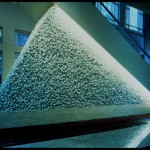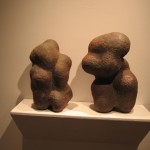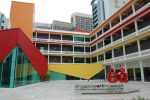Post by Mei-ling Hom and David McClellan
 The poster for the Krungthep 226 exhibition shows the Victory Monument overhelmed by jungle.
The poster for the Krungthep 226 exhibition shows the Victory Monument overhelmed by jungle.
This is part 3 of a report from Asia. Part I, on 8Q, the new Singapore art museum, is here. And Part 2, on experiencing a Thai foundry, is here. The long awaited first public contemporary art museum in Thailand has finally opened with an exhibition entitled “Krungthep 226”. Now there was one earlier exhibition but the tale of how that came to replace this one as the actual first is too tangled to relate here. So I will just describe this big show as the kickoff event. Krungthep is the Thai name for the city known as Bangkok and 226 is the number of years since its founding as capital after the destruction of the previous capital of Ayuthaya by a Burmese army. The show has two main sections; one dealing with the first 200 years and the other section covering roughly the last 26.  Bangkok’s new Art and Culture Centre sits on a prime center city shopping corner. These two sections are on two floors of the 7-story building which is a frank homage to the Guggenheim with a central atrium and spiral ramps (uncomfortably steep in this case). The first 5 floors of museum are a combination of meeting spaces and shops which haven’t been rented yet. On our last visit the shops were being used for a grad school thesis show by a local university. Interestingly the funding for the museum has come from the city of Bangkok, not the government of Thailand which maintains the somnolent National Gallery.
Bangkok’s new Art and Culture Centre sits on a prime center city shopping corner. These two sections are on two floors of the 7-story building which is a frank homage to the Guggenheim with a central atrium and spiral ramps (uncomfortably steep in this case). The first 5 floors of museum are a combination of meeting spaces and shops which haven’t been rented yet. On our last visit the shops were being used for a grad school thesis show by a local university. Interestingly the funding for the museum has come from the city of Bangkok, not the government of Thailand which maintains the somnolent National Gallery.  A watercolor by Tiawat Putarakulvanich. The show is a sprawling amalgam of painting, installation, and sculpture with a bit of photography and several video screening areas thrown in. The central idea is a commentary on life in the city at present and a vision of what it could be like in the future. Although there are a few lyrical views of corners of the city like the watercolors by Tiawat Putarakulvanich which appear in a weekly newspaper…
A watercolor by Tiawat Putarakulvanich. The show is a sprawling amalgam of painting, installation, and sculpture with a bit of photography and several video screening areas thrown in. The central idea is a commentary on life in the city at present and a vision of what it could be like in the future. Although there are a few lyrical views of corners of the city like the watercolors by Tiawat Putarakulvanich which appear in a weekly newspaper…  Hakoshima Yasumi’s view of an old style city bus …or the wonderful drawings by Hakoshima Yasumi of the interiors of the local buses, most of the paintings are critical of failings in daily life or the hazards of the built environment.
Hakoshima Yasumi’s view of an old style city bus …or the wonderful drawings by Hakoshima Yasumi of the interiors of the local buses, most of the paintings are critical of failings in daily life or the hazards of the built environment.  A thronged city of Bangkok by Kwanchai Lichaikul In this year of dramatic political strife in Thailand Kwanchai Lichaikul’s enormous and intricate “Boom 2008” presents a minutely rendered city replete with demonstrations and terrorist training exercises amidst the normal workaday world of construction and business.
A thronged city of Bangkok by Kwanchai Lichaikul In this year of dramatic political strife in Thailand Kwanchai Lichaikul’s enormous and intricate “Boom 2008” presents a minutely rendered city replete with demonstrations and terrorist training exercises amidst the normal workaday world of construction and business.  Wasan Sitthiket runs for office on the Artist’s Party ticket. Our 2 months here has been dominated by the unstable political atmosphere starting with the shutdown of the international airport by a sit-in which delayed our arrival for a week. The newspapers have been headlined every morning with new machinations of the opposing factions and the streets have been lined with posters touting candidates for the governor of Bangkok (the recently elected one was removed for corruption). So the goofy picture of artist Wasan Sitthiket on his own campaign poster brought a smile to our faces. After becoming disenchanted with the available political choices he formed and registered “The Artist’s Party” with a platform calling for a “noncontrolling heart”.
Wasan Sitthiket runs for office on the Artist’s Party ticket. Our 2 months here has been dominated by the unstable political atmosphere starting with the shutdown of the international airport by a sit-in which delayed our arrival for a week. The newspapers have been headlined every morning with new machinations of the opposing factions and the streets have been lined with posters touting candidates for the governor of Bangkok (the recently elected one was removed for corruption). So the goofy picture of artist Wasan Sitthiket on his own campaign poster brought a smile to our faces. After becoming disenchanted with the available political choices he formed and registered “The Artist’s Party” with a platform calling for a “noncontrolling heart”.  Chatchai Puipia’s sculpture critizes politics and the citizenry. Another insouciant criticism of politics and the citizenry is Chatchai Puipia’s sculpture incorporating a bronze casting of a crossed pair of male legs and a separate rounded butt perched on a street vendors cart which is flying a tattered Thai flag made of chicken wire. Perhaps Chatchai’s citizen is avoiding joining the tumult of the opposing yellow-shirted and red-shirted factions by having no torso.
Chatchai Puipia’s sculpture critizes politics and the citizenry. Another insouciant criticism of politics and the citizenry is Chatchai Puipia’s sculpture incorporating a bronze casting of a crossed pair of male legs and a separate rounded butt perched on a street vendors cart which is flying a tattered Thai flag made of chicken wire. Perhaps Chatchai’s citizen is avoiding joining the tumult of the opposing yellow-shirted and red-shirted factions by having no torso.  Bangkok’s periennial problems with water management are the subject of Top Changtrakul’s drawing. From criticism of the present, several artists leapt forward to an imagined Bangkok of the future. Top Changtrakul draws immense spare diagrams of busy scenes that lose their figurative meaning as the viewer steps back and become vivid patterns like weavings. In contrast Tatiya Udomsat’s digital images of familiar Bangkok landscapes are readable at any distance as cautionary tales about how puny the efforts of homo sapiens are compared to the vigor of the thousands of species just waiting for a few rainy seasons to overwhelm the post apocalyptic city.
Bangkok’s periennial problems with water management are the subject of Top Changtrakul’s drawing. From criticism of the present, several artists leapt forward to an imagined Bangkok of the future. Top Changtrakul draws immense spare diagrams of busy scenes that lose their figurative meaning as the viewer steps back and become vivid patterns like weavings. In contrast Tatiya Udomsat’s digital images of familiar Bangkok landscapes are readable at any distance as cautionary tales about how puny the efforts of homo sapiens are compared to the vigor of the thousands of species just waiting for a few rainy seasons to overwhelm the post apocalyptic city.  Richard Tsao Another artist concerned with the yearly flooding is Richard Tsao who uses water based colors to tint his flooded studio and then sops up the color with paper.
Richard Tsao Another artist concerned with the yearly flooding is Richard Tsao who uses water based colors to tint his flooded studio and then sops up the color with paper.  A beautiful example ofmuseum giftshops; a nostalgic reconstruction of a 1950s corner store. Although the show was fairly crowded and some of the soundtracks from installations bled out into surrounding gallery spaces. the energy level of the artists was high and the occasional limp efforts were strongly outweighed by fresh ideas and slyly pointed criticism. The brand new Bangkok Art and Culture Centre is undergoing normal growing pains in the face of the world economic crisis and a lack of an experienced permanent staff but Krungthep 226 is a strong first effort in an attempt to put Bangkok on the world art map.
A beautiful example ofmuseum giftshops; a nostalgic reconstruction of a 1950s corner store. Although the show was fairly crowded and some of the soundtracks from installations bled out into surrounding gallery spaces. the energy level of the artists was high and the occasional limp efforts were strongly outweighed by fresh ideas and slyly pointed criticism. The brand new Bangkok Art and Culture Centre is undergoing normal growing pains in the face of the world economic crisis and a lack of an experienced permanent staff but Krungthep 226 is a strong first effort in an attempt to put Bangkok on the world art map.







